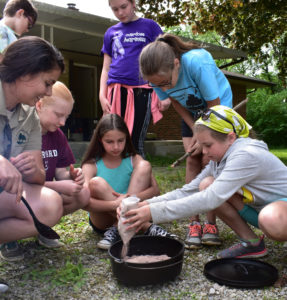 By Liz Neroni, naturalist
By Liz Neroni, naturalist
Every morning I wake up and cook breakfast on an item that is more than 128 years old.
When I crack the shell of a free-range egg and hear the sizzle, two of my favorite things collide: the benefits of raising my own backyard chickens as well as my love for cast iron cookware.
The story of why I cook on something from the 1800s starts with, of all things, a parrot. When I adopted my first parrot, I learned that I had to change a lot of things in my home, including cookware, cleaning supplies, and even the candles I burned. Parrots have very sensitive lungs and they can die if they inhale certain fumes. So I started this journey because I needed pots and pans that weren’t coated in Teflon. After doing some research, I acquired a heavy skillet and some stainless-steel pots.
I enjoyed using the cast iron, but I hadn’t fully developed a passion at that point. That changed when I assisted in the Dutch oven outdoor cooking program that was established at a Maryland State Park where I worked at the time. Using the cast iron in such a different way really made it more interesting. There is something unique about cooking in nature!
However, it was the instructor of the program who really got me hooked, by opening my eyes to everything cast iron has to offer. I had purchased my new skillet from the store, not even realizing that this method of cooking was far from new and not just for outdoor enthusiasts. Now I discovered that cast iron was used throughout history. I could find skillets, griddles, pots, Dutch ovens, chicken fryers, and more that were no longer manufactured hidden in antique stores, garage sales, barn auctions, and even Goodwill stores.
Then it became a sort of art. I started restoring rusty discarded pieces to create something that I could really use for my new recipes. But beyond that, I discovered that every one of those antique pieces has a story and I wanted to know all I could. Where it was made? Who made it? When was it manufactured? What was it made for? All questions that truly fascinated me! My kitchen is now littered with cast iron from different time periods, including my gate marked skillet. What is a gate mark? The picture below shows this characteristic line on the bottom of the pan. This raised slash is a result of a specific casting process, which was discontinued around 1890. So a gate mark means it is very old!
With all the secrets these cooking implements hold, I continue to learn new things all the time. If you want to see amazing cast iron cookware in action, stop by Gallant Farm where you can see farm staff cooking with it on a wood burning stove. You can also join Preservation Parks at the free Outdoor Exploration Expo on Saturday, Oct. 13, 10 a.m.-5 p.m. at Camp Lazarus. There, you can personally experience outdoor cooking with cast iron, as one of the many outdoor experiences we’ll offer at the expo.
Fair warning though: cast iron cooking is quite addictive once you see how great this cookware really is!







